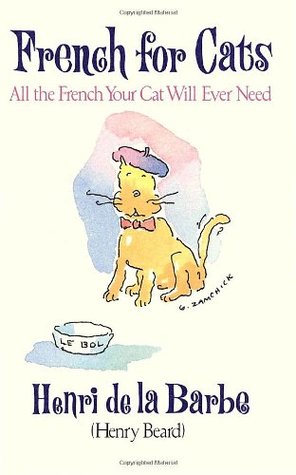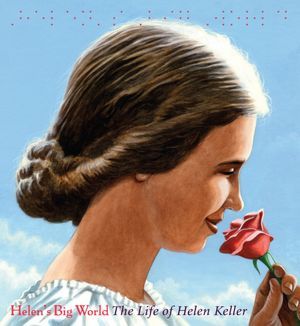Favorite nonfiction picture book: Helen's Big World. Doreen Rappaport. Illustrated by Matt Tavares. 2012. 48 pages. [Source: Library]
Favorite early chapter or early reader: Stop Stop. Edith Thacher Hurd. Illustrated by Clement Hurd. 1961. 64 pages. [Source: Bought]
Favorite poetry: Wet Cement. Bob Raczka. 2016. 48 pages. [Source: Library] [POETRY]
Favorite realistic fiction: Piecing Me Together. Renee Watson. 2017. Bloomsbury. 272 pages. [Source: Review copy]
Favorite Speculative Fiction: Norse Mythology. Neil Gaiman. 2017. Norton. 299 pages. [Source: Library]
Favorite classic: Barchester Towers. Anthony Trollope. 1857. 418 pages. [Source: Bought]
Favorite nonfiction: Ugly. Robert Hoge. 2016. 208 pages. [Source: Library]
Favorite novelty: And the Beagles and the Bunnies Shall Lie Down Together. Charles M. Schulz. 1984. 100ish pages. [Source: Gift]
Favorite Christian nonfiction: Reading the Bible Supernaturally. John Piper. 2017. Crossway. 320 pages. [Source: Review copy]
Board books and picture books:
- Finn Throws A Fit. David Elliott. Illustrated by Timothy Basil Ering. 2009. Candlewick. 32 pages. [Source: Review copy]
- A Cat Named Swan. Holly Hobbie. 2017. Random House. 32 pages. [Source: Library]
- That's Me Loving You. Amy Krouse Rosenthal. Illustrated by Teagan White. 2016. [December] 40 pages. [Source: Library]
- Board book: Tinyville Town: I'm A Librarian. Brian Biggs. 2017. Abrams. 22 pages. [Source: Review copy]
- Strega Nona. Tomie dePaola. 1975. 32 pages. [Source: Library]
- Wolf's Story. Toby Forward. Illustrated by Izhar Cohen. 2005. 32 pages. [Source: Library]
- The Rooster Crows. Maud and Miska Petersham. 1945. (Caldecott Medal) 64 pages. [Source: Library]
- ABC Bunny. Wanda Gag. 1933. 40 pages. [Source: Library]
- Board book: Charlie Rides. Bob Bianchini. 2017. Abrams. 20 pages. [Source: Review copy]
- Helen's Big World. Doreen Rappaport. Illustrated by Matt Tavares. 2012. 48 pages. [Source: Library]
- Pancakes for Breakfast. Tomie dePaola. 1978. 32 pages. [Source: Library]
- Pancakes, Pancakes! Eric Carle. 1970. 36 pages. [Source: Library]
- A Piece of Cake. LeUyen Pham. 2014. 40 pages. [Source: Library]
- Swap. Steve Light. 2016. Candlewick. 40 pages. [Source: Review copy]
- Caps for Sale. Esphyr Slobodkina. 1938. 48 pages. [Source: Library]
- Runaway Bunny. Margaret Wise Brown. Illustrated by Clement Hurd. 1942. 48 pages. [Source: Library]
- Quiet! There's A Canary in the Library. Don Freeman. 1969. 48 pages. [Source: Library]
- Round. Joyce Sidman. 2017. HMH. 32 pages. [Source: Review copy]
- Dorothea Lange: The Photographer Who Found the Faces of The Depression. Carole Boston Weatherford. Illustrated by Sarah Green. 2017. 32 pages. [Source: Library]
- Just a Lucky So and So. Lesa Cline-Ransome. Illustrated by James Ransome. 2016. Holiday House. 32 pages. [Source: Library]
- Stop Stop. Edith Thacher Hurd. Illustrated by Clement Hurd. 1961. 64 pages. [Source: Bought]
- Thomas Edison and His Bright Idea. Patricia Brennan Demuth. Illustrated by Jez Tuya. 2016. Penguin. 48 pages. [Source: Library]
- Who Was Laura Ingalls Wilder? Patricia Brennan Demuth. 2013. 112 pages. [Source: Library]
- Dr. Seuss: The Great Doodler. Kate Klimo. Illustrated by Steve Johnson and Lou Fancher. 2016. Random House. 48 pages. [Source: Library]
- Enchanted Pony Academy #1 All That Glitters. Lisa Ann Scott. 2017. Scholastic. 128 pages. [Source: Review copy]
- Enchanted Pony Academy #2 Wings That Shine. Lisa Ann Scott. 2017. Scholastic. 128 pages. [Source: Review copy]
- Mouse Scouts: Camp Out (#3) Sarah Dillard. 2016. Random House. 144 pages. [Source: Review copy]
Contemporary (general/realistic) fiction, all ages:
- How To Steal A Dog. Barbara O'Connor. 2007. 170 pages. [Source: Review copy]
- Piecing Me Together. Renee Watson. 2017. Bloomsbury. 272 pages. [Source: Review copy]
- Need. Joelle Charbonneau. 2015. HMH. 335 pages. [Source: Review copy]
- Norse Mythology. Neil Gaiman. 2017. Norton. 299 pages. [Source: Library]
- Horizon #1. Scott Westerfeld. 2017. Scholastic. 256 pages. [Source: Review copy]
- Trumpet of the Swan. E.B. White. Illustrated by Fred Marcellino. 1970. 272 pages. [Source: Library]
- Stuart Little. E.B. White. Illustrated by Garth Williams. 1945. 131 pages. [Source: Library]
- The Quincunx by Charles Palliser. 1990. 787 pages. [Source: Library]
- A Stolen Heart. Amanda Cabot. 2017. Revell. 352 pages. [Source: Review copy]
Classics, all ages:
- Barchester Towers. Anthony Trollope. 1857. 418 pages. [Source: Bought]
- Confidence. Henry James. 1879. 224 pages. [Source: Bought]
- Murder in the Cathedral. T.S. Eliot. 1930. 88 pages. [Source: Library]
- Bobbs Merril Third Reader. Edited by Clara Belle Baker and Edna Dean Baker. 1924/30/39. 293 pages. [Source: Bought]
- Trumpet of the Swan. E.B. White. Illustrated by Fred Marcellino. 1970. 272 pages. [Source: Library]
- The Skin of Our Teeth. Thornton Wilder. 1942. 176 pages. [Source: Library]
- The Best Short Stories. Fyodor Dostoyevsky. Translated by David Magarshack. 2001. 320 pages. [Source: Library]
- Ugly. Robert Hoge. 2016. 208 pages. [Source: Library]
- Some Writer: The Story of E.B. White. 2016. HMH. 176 pages. [Source: Review copy]
- Caught in the Revolution. Helen Rappaport. 2017. 464 pages. [Source: Review copy]
- Diary of a Beautiful Disaster. Kristin Bartzokis. 2017. KiCam Projects. 162 pages. [Source: Review copy]
- Wet Cement. Bob Raczka. 2016. 48 pages. [Source: Library] [POETRY]
- Thomas Edison and His Bright Idea. Patricia Brennan Demuth. Illustrated by Jez Tuya. 2016. Penguin. 48 pages. [Source: Library] [BIOGRAPHY]
- Who Was Laura Ingalls Wilder? Patricia Brennan Demuth. 2013. 112 pages. [Source: Library] [BIOGRAPHY]
- Dr. Seuss: The Great Doodler. Kate Klimo. Illustrated by Steve Johnson and Lou Fancher. 2016. Random House. 48 pages. [Source: Library] [BIOGRAPHY]
- Dorothea Lange: The Photographer Who Found the Faces of The Depression. Carole Boston Weatherford. Illustrated by Sarah Green. 2017. 32 pages. [Source: Library] [BIOGRAPHY
- Helen's Big World. Doreen Rappaport. Illustrated by Matt Tavares. 2012. 48 pages. [Source: Library] [BIOGRAPHY]
- Just a Lucky So and So. Lesa Cline-Ransome. Illustrated by James Ransome. 2016. Holiday House. 32 pages. [Source: Library]
- Poetry for Cats: The Definitive Anthology of Distinguished Feline Verse. Henry Beard. 1994. 96 pages. [Source: Borrowed.]
- French for Cats. Henry N. Beard. 1991. 96 pages. [Borrowed]
- Advanced French for Exceptional Cats. Henry N. Beard. 1992. 96 pages. [Source: Borrowed]
- A Stolen Heart. Amanda Cabot. 2017. Revell. 352 pages. [Source: Review copy]
- And the Beagles and the Bunnies Shall Lie Down Together. Charles M. Schulz. 1984. 100ish pages. [Source: Gift]
- A Little Book on the Christian Life. John Calvin. Edited by Buck Parsons and Aaron Denlinger. 2017. Reformation Trust. 132 pages. [Source: Review copy]
- Reading the Bible Supernaturally. John Piper. 2017. Crossway. 320 pages. [Source: Review copy]
- The New City Catechism Devotional. Collin Hansen, ed. Introduction by Timothy Keller. 2017. Crossway. 224 pages. [Source: Review copy]
- The Curious Christian. Barnabas Piper. 2017. B&H. 176 pages. [Source: Review copy]
- Jews Don't Need Jesus…and Other Misconceptions: Reflections of a Jewish Believer. Avi Snyder. 2017. Moody. 176 pages. [Source: Review copy]
- Finding God in My Loneliness. Lydia Brownback. 2017. Crossway. 174 pages. [Source: Review copy]
- Reset: Living a Grace-Paced Life in a Burnout Culture. David Murray. 2017. Crossway. 224 pages. [Source: Review copy]
- The Titanic's Last Hero: A Startling True Story That Can Change Your Life Forever. Moody Adams. 2012. 120 pages. [Source: Bought]
- Through the Eyes of a Lion. Levi Lusko. 2015. Thomas Nelson. 240 pages. [Source: Bought]
- Holy Bible. 21st Century King James Version (KJ21) Edited by William D. Prindle. 1888 pages. [Source: Bought]
© 2017 Becky Laney of Becky's Book Reviews

































